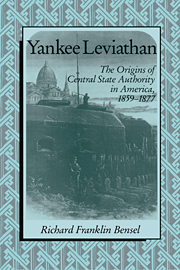Book contents
- Frontmatter
- Contents
- Preface
- 1 Modernization, southern separatism, and state formation in American political development
- 2 The political economy of secession and civil war
- 3 War mobilization and state formation in the northern Union and southern Confederacy
- 4 Gold, greenbacks, and the political economy of finance capital after the Civil War
- 5 Legislation, the Republican party, and finance capital during Reconstruction
- 6 State structure and Reconstruction: The political legacy of the Civil War
- 7 Southern separatism and the class basis of American politics
- Index
2 - The political economy of secession and civil war
Published online by Cambridge University Press: 16 September 2009
- Frontmatter
- Contents
- Preface
- 1 Modernization, southern separatism, and state formation in American political development
- 2 The political economy of secession and civil war
- 3 War mobilization and state formation in the northern Union and southern Confederacy
- 4 Gold, greenbacks, and the political economy of finance capital after the Civil War
- 5 Legislation, the Republican party, and finance capital during Reconstruction
- 6 State structure and Reconstruction: The political legacy of the Civil War
- 7 Southern separatism and the class basis of American politics
- Index
Summary
The American man-of-war is a noble spectacle. I have seen it enter an ancient port in the Mediterranean. All the world wondered at it, and talked of it. Salvos of artillery, from forts and shipping in the harbor, saluted its flag. Princes and princesses and merchants paid it homage, and all the people blessed it as a harbinger of hope for their own ultimate freedom. I imagine now the same noble vessel again entering the same haven. The flag of thirty-three stars and thirteen stripes has been hauled down, and in its place a signal is run up, which flaunts the device of a lone star or a palmetto tree. Men ask, “Who is the stranger that thus steals into our waters?” The answer contemptuously given is, “she comes from one of the obscure republics of North America. Let her pass on.”
– Senator William H. Seward in the United States Senate, January 12, 1861Any study of the origins of the American state must address two questions posed by the Civil War: Why did the South secede from the Union? and why did the North resist secession? Both questions, from a political-economy perspective, involve the relationship of the two regions to the American state. For the South, the American nation in 1860 was a confederation of sovereign states.
- Type
- Chapter
- Information
- Yankee LeviathanThe Origins of Central State Authority in America, 1859–1877, pp. 18 - 93Publisher: Cambridge University PressPrint publication year: 1991

